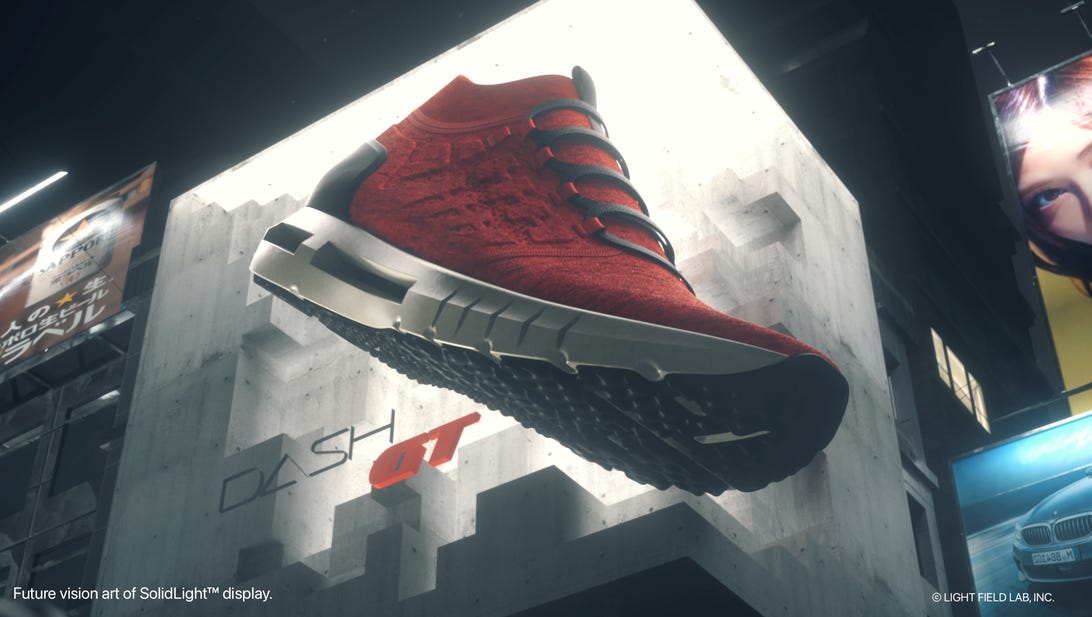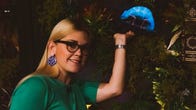
Future vision art of a SolidLight Display.
Light Field LabHolograms. Practically every sci-fi movie and TV show from the last 50 years has some version of this futuristic technology. A realistic 3D object composed of nothing more than light, usually hovering over a table or interacting with our heroes, just screams "This is the future!"
After countless disappointing versions of the technology, a startup called Light Field Lab has started production on a technology it calls SolidLight, which is designed to produce real-life holograms. The promise is basically Star Trek's holodeck, minus the tactility and murderous Moriartys (hopefully). Here's how it works.
What is (and isn't) a hologram
Maybe you're thinking "Big deal, I've seen holograms for years!" Well, yes and no. The vast majority of visual effects called "holograms" are nothing of the sort. For instance, if you've ever experienced the Haunted Mansion ride at a Disney park, the dancing ghosts are neither real ghosts (sorry, spoiler), nor are they holograms. They use a technique called "Pepper's ghost" which dates back to the early 1800's. This is also how Tupac performed "live" on stage 16 years after his death.
Also not holograms? The spinning LED image creators that were all over CES a few years ago. 3D displays, VR and AR are all hologram-like, but not the real thing. Even Looking Glass' 3D picture frames aren't holograms, they're autostereoscopic, aka glasses-free 3D, the same technology found on the Nintendo 3DS.
What we all want, when we think of "holograms," is something that seems to appear in space, just like a real object would. Not something confined inside a special tiny screen, only viewable from a narrow angle. Ideally, we want a holodeck, or at least Princess Leia asking Obi-wan for help.
So. Many. Pixels

Future vision art of SolidLight Display. Imagine instead of a standard foosball table, you can play against your friends on an ultra-high-resolution, holographic soccer pitch.
Light Field LabLight Field Lab's SolidLight tech sounds like science fiction. They company is aiming to, basically, re-create objects in the real world with light, just like a sci-fi holodeck. The physics of how they're aiming to get this to work is actually rather simple. Well, simple in concept, definitely not simple in execution.
Essentially, they're causing waves of light to interact at a specific point, and that interaction is visible to your eye. By doing this a lot, they can create the illusion of an entire object "made" of light.
And when I say a lot, I mean a lot. Their 28-inch diagonal panel has 2.5 billion pixels. For comparison, a 4K TV has 8.2 million. They're envisioning holographic video walls made up of these smaller panels, with upward of 245 billion pixels.
These pixels are far more complex than those on your phone or TV screen. They're able to precisely manipulate the phase of the light waves so the interactions of those waves create the holographic effect. Standard LCD or OLED pixels just need to create red, green, and blue. SolidLight's pixels need to create specific colors in a specific place in front of the display so the image appears to pop out of the screen.

Some of you might be familiar with Yamaha's Intellibeam audio technology, which uses an array of tweeters to make it seem like sound is coming from anywhere in the room but the soundbar. This is essentially the same thing, just on a microscopic scale since waves of light are orders of magnitude smaller than the air molecules that make up soundwaves.
Your field of view with the SolidLight display is basically whatever your field of view is with the display. Which is to say, if you're viewing the display from 180 degrees to the side, you don't see the hologram. This isn't quite that level of magic (yet). There still needs to be an imaginary line between your eye and the screen for the hologram to appear in between.

Future vision art of SolidLight Display. Imagine one wall of a conference room that allows you to view projects in holographic 3D.
Light Field LabWhat makes SolidLight interesting is that you don't need any special glasses for it to work, nor do you need to be directly in front of the screen. You can still be at an angle, and whatever amount of your eye's field of view is filled with the SolidLight display, you'll see the hologram.
And because the tech is scalable, you could have a much larger display and much larger holograms. Imagine wall-sized holographic displays and how they could be game-changers for entertainment. Forget about VR headsets, how about VR rooms. You could have an entire room that's got SolidLight displays on all four walls, the floor and the ceiling, and you'd just about have a holodeck. Or at least as close as modern tech can be.
That sort of thing should be possible, eventually, but for now the company's goals for the tech are a little more realistic. They're aiming to make holographic displays ranging from desktop to wall-sized. The latter will be the most impressive, I think. Holographic, interactive walls for meetings and collaboration, or to impress visitors to corporate offices.
Computer, end program

How about instead of billboards or flat, wrap advertising, a hologram that leaps out of a wall? Back to the Future Part II anyone?
Light Field LabSilicon Valley is rife with random startups that somehow get capital, but the investors in Light Field Lab are like a who's who of serious tech, including Samsung, Comcast and Verizon. They company has already sold out on preorders, which is to say, this isn't all theoretical, they're actually building them.
History is also rife with companies claiming holography and coming-soon holodeck-style tech, but SolidLight has some fascinating physics that could be the breakthrough that holograms need to be mainstream.
Will this be your next TV, or even your next, next TV? No. But you should start seeing these displays in the real world as early as next year. They're already in preproduction, with the hope of soon going into mass production for a variety of sizes.
"light" - Google News
October 07, 2021 at 07:15PM
https://ift.tt/3BkF39D
Holograms get real: Startup creates objects out of light and thin air - CNET
"light" - Google News
https://ift.tt/2Wm8QLw
https://ift.tt/2Stbv5k
Bagikan Berita Ini
















0 Response to "Holograms get real: Startup creates objects out of light and thin air - CNET"
Post a Comment